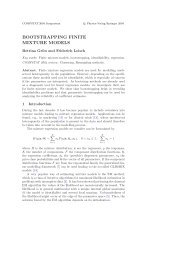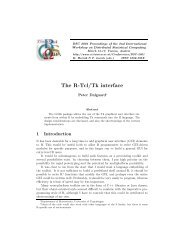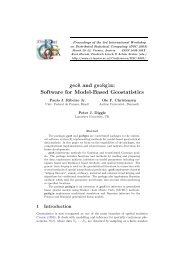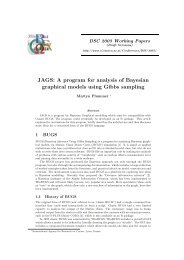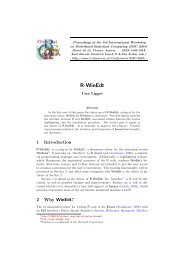Embedding R in Windows applications, and executing R remotely
Embedding R in Windows applications, and executing R remotely
Embedding R in Windows applications, and executing R remotely
You also want an ePaper? Increase the reach of your titles
YUMPU automatically turns print PDFs into web optimized ePapers that Google loves.
Tak<strong>in</strong>g <strong>in</strong>to account spatial dependence <strong>in</strong> multivariate analysis<br />
Sébastien Ollier, Anne-Béatrice Dufour, Jean Thioulouse, Daniel Chessel<br />
Laboratoire de Biométrie et de Biologie Evolutive. UMR CNRS 5558, Villeurbanne, France.<br />
Abstract<br />
R is a valuable tool to develop statistical methods us<strong>in</strong>g its package structure <strong>and</strong> the open<br />
sources. Indeed, it allows comb<strong>in</strong><strong>in</strong>g classes <strong>and</strong> methods from different packages <strong>in</strong> order to<br />
generalize their own capabilities. The present topic deals with the relationship between classes <strong>and</strong><br />
methods from both packages.spdep <strong>and</strong> ade4, which implement methods for spatial data analysis<br />
(ma<strong>in</strong>ly lattice/area style) <strong>and</strong> multivariate analysis respectively. Comb<strong>in</strong><strong>in</strong>g objects from both<br />
packages leads to the development of a new statistical method to take <strong>in</strong>to account spatial<br />
dependence <strong>in</strong> multivariate analysis.<br />
spdep is a package def<strong>in</strong>ed by Biv<strong>and</strong> as “a collection of functions to create spatial weights matrix W<br />
from polygon cont<strong>in</strong>uities, from po<strong>in</strong>t patterns by distance <strong>and</strong> tessellations for permitt<strong>in</strong>g their use <strong>in</strong><br />
spatial data analysis”. Two classes of objects have been established: “nb” a list of vectors of neighbour<br />
<strong>in</strong>dices, <strong>and</strong> “listw” a list conta<strong>in</strong><strong>in</strong>g a “nb” member <strong>and</strong> a correspond<strong>in</strong>g list of weights for a chosen<br />
weight<strong>in</strong>g scheme. The package conta<strong>in</strong>s <strong>in</strong> addition many functions to test spatial autocorrelation <strong>and</strong><br />
estimate spatial autoregressive model but it only supports univariate data analysis.<br />
ade4 is precisely a package dedicated to multivariate analysis of Ecological <strong>and</strong> Environmental Data<br />
<strong>in</strong> the framework of Euclidean Exploratory methods. It is a collection of functions to analyse the<br />
statistical triplet (X,Q,D) where X is a data set of variables or a distance matrix; Q <strong>and</strong> D are diagonal<br />
matrices conta<strong>in</strong><strong>in</strong>g column <strong>and</strong> row weights, respectively. The s<strong>in</strong>gular value decomposition of this<br />
triplet gives pr<strong>in</strong>cipal axes, pr<strong>in</strong>cipal components <strong>and</strong>, column <strong>and</strong> row coord<strong>in</strong>ates. All these elements<br />
are gathered <strong>in</strong> a list def<strong>in</strong><strong>in</strong>g the duality diagram class called “dudi”. Each basic statistical method<br />
corresponds to the analysis of a particular triplet. For <strong>in</strong>stance, ade4 implement the pr<strong>in</strong>cipal<br />
component analysis on correlation matrix via a function called “dudi.pca”. In that case, X is a table<br />
conta<strong>in</strong><strong>in</strong>g normalized quantitative variables, Q is the identity matrix<br />
I<br />
p<br />
<strong>and</strong> D is equal to 1 n<br />
n I .<br />
An illustration of the relationship between spdep <strong>and</strong> ade4 is shown through the “multispati”<br />
function. This function comb<strong>in</strong>es objects of class ”listw “ with objects of class “dudi” to analyse the<br />
statistical quadruplets (X,Q,D,W). It allows first, the generalisation of the univariate Moran test <strong>and</strong><br />
second, to take <strong>in</strong>to account spatial constra<strong>in</strong>ts <strong>in</strong> Euclidean Exploratory methods. Dur<strong>in</strong>g this talk, the<br />
implementation of multivariate spatial correlations analysis proposed by Wartenebrg (1985) will be<br />
described as a particular use of the “multspati” function.<br />
Wartenberg, D. E. 1985. Multivariate spatial correlations: a method for exploratory geographical<br />
analysis. Geographical Analysis 17:263-283.




